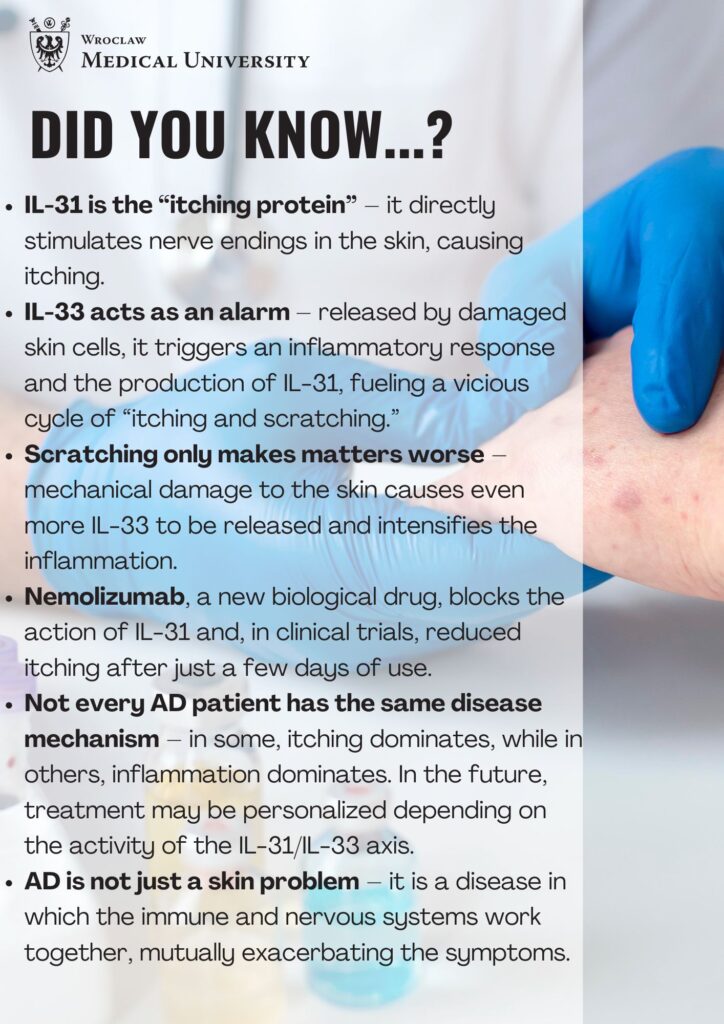Atopic dermatitis (AD) is a chronic disease that affects an increasing number of children and adults. The skin is dry and irritated, and the itching can be so severe that it interferes with sleep and daily life. Although AD has been discussed for years, it is only now that scientists are beginning to understand exactly why the disease causes so much itching.
A team of students from the Student Scientific Association and researchers from Wroclaw Medical University and Medical University of Silesia in Katowice described in the International Journal of Molecular Sciences the so-called IL-31/IL-33 axis – a mechanism that drives inflammation and itching in atopic dermatitis.
How the “itch axis” works
When the skin is damaged or severely irritated, its cells secrete a protein called IL-33. This is a kind of “alarm” for the immune system—a signal that the protective barrier has been breached. In response, an inflammatory reaction is triggered, and another protein, IL-31, is produced, which directly stimulates the skin’s nerves.
This results in intense itching, which leads to scratching. Scratching further damages the epidermis, so the skin releases even more IL-33 – and the cycle starts all over again. Scientists call this the vicious circle of “itching and scratching.”
“We have long observed that in AD, the immune and nervous systems stimulate each other, but only now can we better understand exactly how this works,” says Dr. Krzysztof Gomułka, assistant professor at the Department and Clinic of Allergology and Internal Medicine at Wroclaw Medical University. “The IL-31/IL-33 axis is like a line of communication between skin cells, nerves, and the immune system that drives both inflammation and itching.”
New drugs on the horizon
The discovery of this relationship opens up new treatment possibilities. Nemolizumab, a biological drug that blocks IL-31 signaling, is the most promising. In clinical trials, it significantly reduced itching after just a few days of use and improved sleep quality in patients with severe AD.
“IL-31 is directly responsible for the feeling of itching, so blocking it brings quick and noticeable results,” explains Dr. Gomułka. “In the case of IL-33, the matter is more complex. This protein triggers inflammation, but other molecules often override its effects. Hence, the impact of IL-33-blocking therapies is weaker or more prolonged.”
Researchers believe that IL-33 plays a greater role in only some patients, which is why, in the future, AD treatment may become increasingly personalized—tailored to the profile of a specific patient.
“This is a significant direction, because not every AD patient has the same disease mechanism,” adds the scientist. “In some, symptoms related to itching predominate, while in others, the inflammatory process prevails. In the future, we want to be able to distinguish between these and treat them more specifically.”
What this means for patients
Understanding how IL-31 and IL-33 work together allows us to look at AD in a new way – not just as a skin problem, but as a disease in which the immune and nervous systems stimulate each other.
Scientists are one step closer to developing therapies that not only alleviate symptoms but also interrupt the mechanism causing itching at its source.-

This material is based on the article:
IL-31/33 axis in atopic dermatitis
International Journal of Molecular Sciences, 2025
Authors: Łacwik Julia, Krzysztof Kraik, Laska Julia, Maciej Tota, Sędek Łukasz, Gomułka Krzysztof